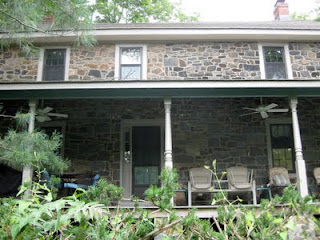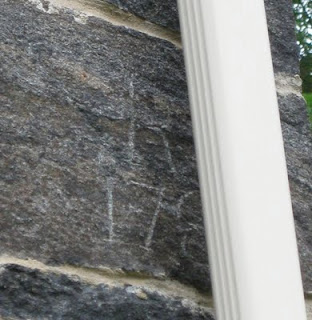The information sent to me came from Stephen Ruszkowski, a local artist, many of whose works depict the historic structures of northern New Castle County. Oh yeah -- and he grew up in the Mendenhall House. (One of his depictions of the house can be seen below.) Stephen's information made a few things very clear, allowed reasonable guesses for others, and left at least one big mystery. One thing that is very clear to me now is that contrary to what I wrote in the first post (and in line with what I vaguely corrected in the second), the house was not built by James Mendenhall, c.1783. It now seems certain it was not built by a Mendenhall at all. In fact, it likely is a good bit older.
 |
| Mill House #1 by Stephen Ruszkowski |
The "JP" in question seems, most likely, to be James Philips. Stephen found record of a sale of 150 acres from James Philips to William Philips, in 1763. It is noted that James Philips had purchased the land from Joseph Buckingham (although I wonder if that's not supposed to be John) in 1753. Philips also purchased a smaller lot that specifically stated it was "whereon the mill stands". Although the Philips family is one of those with multiple lines with many of the same names, we're probably dealing with James Philips (1676-1772) and his son, William (1710-1790). I know that they were a family of millers, as William's son Robert (1746-1828) purchased the Greenbank Mill in 1773.
As for the identity of "RG", I am, for the moment, stumped. I have combed through everything I could find (as has Stephen) about any "G" family that might have been in the area in 1780. Among others, I've checked Guthrie, Gregg, Garrett, Graves, Grimes, and Griffin. So far, not a single male with an R name anywhere near 1780. Since both sets of initials are on the "newer" section, my guess is that this addition was built by "RG" in 1780, and the "JP" is either an older stone from a dismantled wall, or simply a commemoration of the original builder of the house. Since I've come up with nothing yet, RG may be from a family I have not checked, or may be a member who was not included on the lists I found. If anyone has any ideas, feel free to throw in any guesses.
Since we know that the early mill in the area was jointly owned by several men, this leaves plenty of room for the Philips family, the Mendenhalls, and the "G"s. And as Aaron Mendenhall moved to this area in 1763, we know this was not the original Mendenhall House (which one was is unclear, but there's a house down the road that is a possibility). It may be that not long after RG added on to his house, he sold it to James A. Mendenhall, who may have consolidated ownership of the mill and millseat. James then operated the mill for a number of years, until razing the old mill and replacing it with a new one in 1826. This idea is supported by the caption to the wide-angle picture of the property that appears on the first Mendenhall post. The caption reads, "Built 1826 by JEM replaced log structure owned by Philips during the revolution." This picture, I believe, was from about 1895.
As you see, the history of this house and surrounding land, tucked into the Mill Creek Valley, continues to be revealed. If anyone has any other information about this house, or any of the surrounding properties, I would love hear it. Eventually, I hope we can uncover the whole story of this section of the stream for which Mill Creek Hundred was named.




No comments:
Post a Comment